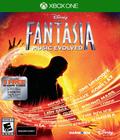Fantasia: Music Evolved is a new game from the minds of the folks at Harmonix and Disney, and I got to spend a few minutes with it on the floor at E3. It's a music rhythm game similar in vein to other Harmonix titles, such as Rock Band or Dance Central but it's less of a "beat-matching" game and is more about letting the player have a hand in producing the music — in a sense.
Most people are at least aware of the existence of "Fantasia," the 1940 Disney animated movie set to orchestral music. Everyone's seen Mickey in his blue wizard hat and red robe, waving his arms at the stars and making brooms do his chores. Fantasia: Music Evolved is a game inspired by the magic of the movie, and though it does include some of the scores from the original film, such as "Night on Bald Mountain," it also includes classic rock hits like "Bohemian Rhapsody" and more modern musicians like Fun and Bruno Mars.
You step into the shoes of Wizard Yen Sid's new apprentice (he's the angry-looking wizard with the long beard who shows up in The Sorcerer's Apprentice in Fantasia), and Yen Sid is teaching you how to use your muse, which is the on-screen cursor, to interact with and change the world around you. This is done through the motion detection of the Kinect, and you can move your cursor along the X, Y and Z axes, not only interacting with things to the left and right of the screen, but also to the front and back, something that has not been utilized with the Kinect thus far.
Under Yen Sid's guidance, you explore different areas and help them evolve and change. For example, in an underwater setting called The Shoal, which I saw, you can play a drum fill on different types of clams – the folks presenting the game referred to this as a Jazz Clam Drum Fill, which I'm calling dibs on for a band name – and it would then play occasionally within the song that plays in that zone. Since this is a music game, the best way to unlock things is to play songs.
The music interface is fairly simple. Arrows show up on the screen, and you wave either arm (or both, if it's called for) in the directions the arrows are pointing. Throughout the song, you have chances to mold the music as you'd like. For example, in Bohemian Rhapsody, you get three options. The pink option continued the music in the original score. The blue option changed the music to be an orchestral arrangement. The green option changed it to an '80s hair metal band style. These options came up perhaps a dozen times in the song, changing and layering as it went until only the bare bones of the song are the same and everything else is your creation. There are also power-up points that let you warp and create guitar solos from the original song and change them into something new. As such, you can do a song 100 times and never have it the same way twice.
It's tough to put Fantasia: Music Evolved into words, really. It sounds simple, even by rhythm game standards, and to an extent, it is. The gameplay isn't difficult to grasp but somewhere between the gestures, you start to feel like you did as a kid, with a stick pretending to conduct your own orchestra, or like Mickey himself, making magic with a wave of your hand. In that way, Fantasia: Music Evolved completely defies description. There is nothing overt about it; the individual pieces are all unobtrusive, uncomplicated, and perhaps even uninteresting, with so many other flashier rhythm games on the market. Proving that the whole is greater than the sum of its parts, Harmonix and Disney have put everything together in the right way, and in doing so, have made something amazing. They've made magic.
More articles about Fantasia: Music Evolved











 Fantasia: Music Evolved transports players to a breathtaking world where music and magic combine to transform extraordinary interactive landscapes in entirely new and creative ways!
Fantasia: Music Evolved transports players to a breathtaking world where music and magic combine to transform extraordinary interactive landscapes in entirely new and creative ways!










